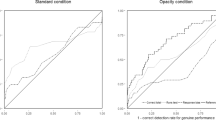Abstract
A two-alternative forced-choice test, two putative malingering tests, and four neuropsychological tests were administered to 105 prison inmates (51 males and 54 females) and 108 university students (54 males and 54 females) in one of three conditions: naive faking, coached faking, and control. Six of the seven tests differentiated faking subjects from controls, but only the forced-choice test differentiated between naive and coached faking. Even though only 11% of the faking subjects performed below the level of chance on the forced-choice test, this test was more sensitive than other tests in distinguishing between faking subjects and controls. The putative malingering tests were the least sensitive measures. The most salient difference between inmates and students was that faking inmates did not respond to a bogus difficulty manipulation in the forced-choice test. The results indicate that the forced-choice method is a sensitive means of detecting dishonest performance even when scores do not fall below chance.
Similar content being viewed by others
References
Binder, L. M. (1993). Assessment of malingering after mild head trauma with the Portland Digit Recognition Test.Journal of Clinical and Experimental Neuropsychology, 15, 170–182.
Binder, L. M., & Pankratz, L. (1987). Neuropsychological evidence of a factitious memory complaint.Journal of Clinical and Experimental Neuropsychology, 9, 167–171.
Binder, L. M., & Willis, S. C. (1991). Assessment of motivation after financially compensable minor head trauma.Psychological Assessment: A Journal of Consulting and Clinical Psychology, 3, 175–181.
Bond, M. R. (1986). Neurobehavioral sequelae of closed head injury. In I. Gant & K. M. Adams (Eds.),Neuropsychological assessment of neuropsychiatric disorders (pp. 347–373). New York: Oxford University Press.
Brandt, J., Rubinsky, E. W., & Lassen, G. (1985). Uncovering malingered amnesia.Annals of the New York Academy of Sciences, 44, 502–503.
Cozby, P. C. (1993).Methods in behavioral research (5th ed.). Mountain View, CA: Mayfield.
Dixon, W. J. (Chief Ed.). (1985).BMDP statistical software. Berkeley: University of California Press.
Faust, D., Hart, K., Guilmette, T. J., & Arkes, H. R. (1988). Neuropsychologists' capacity to detect adolescent malingerers.Professional Psychology: Research and Practice, 42, 508–515.
Guilmette, T. J., Hart, K. J., & Giuliano, A. J. (1993). Malingering detection: The use of a forced-choice method in identifying organic versus simulated memory impairment.The Clinical Neuropsychologist, 7, 59–69.
Haughton, P. M., Lewsley, A., Wilson, M., & Williams, R. G. (1979). A forced-choice procedure to detect feigned or exaggerated hearing loss.British Journal of Audiology, 13, 135–138.
Heaton, R. K., Smith, H. H., Jr., Lehman, R. A., & Vogt, A. (1978). Prospects for faking believable deficit on neuropsychological testing.Journal of Consulting and Clinical Psychology, 46, 892–900.
Hiscock, M., & Hiscock, C. K. (1989). Refining the forced-choice method for the detection of malingering.Journal of Clinical and Experimental Neuropsychology, 11, 967–974.
Kellogg, C. E., & Morton, N. W. (1978).Revised Beta Examination (2nd ed.). San Antonio: Psychological Corp.
Lezak, M. D. (1983).Neuropsychological assessment (2nd ed.). New York: Oxford University Press.
Pankratz, L., Fausti, S. A., & Peed, S. (1975). A forced-choice technique to evaluate deafness in the hysterical or malingering patient.Journal of Consulting and Clinical Psychology, 43, 421–422.
Prigatano, G. P., & Amin, K. (1993). Digit Memory Test: Unequivocal cerebral dysfunction and suspected malingering.Journal of Clinical and Experimental Neuropsychology, 15, 537–546.
Reitan, R. M., & Wolfson, D. (1985).The Halstead-Reitan Neuropsychological Test Battery: Theory and clinical interpretation. Tucson, AZ: Neuropsychology Press.
Rey, A. (1941). L'examen psychologique dans les cas d'encephalopathie traumatique.Archives de Psychologie, 28, 286–340.
Rey, A. (1964).L'examen clinique en psychologie. Paris: Presses Universitaires de France.
Rimel, R. W., & Jane, J. A. (1983). Characteristics of the head-injured patient. In M. Rosenthal, E. R. Griffith, M. R. Bond, & J. D. Miller (Eds.),Rehabilitation of the head injured adult (pp. 9–21). Philadelphia: F. A. Davis.
Rogers, R. (Ed.). (1988).Clinical assessment of malingering and deception. New York: Guilford Press.
Schretlen, D. J. (1988). The use of psychological tests to identify malingered symptoms of mental disorder.Clinical Psychology Review, 8, 451–476.
Siegel, S. (1956).Nonparametric statistics for the behavioral sciences. New York: McGraw-Hill.
Smith, A. (1973).Symbol Digit Modalities Test. Los Angeles: Western Psychological Services.
Trueblood, W., & Schmidt, M. (1993). Malingering and other validity considerations in the neuropsychological evaluation of mild head injury.Journal of Clinical and Experimental Neuropsychology, 15, 578–590.
War Department (1944).Army Individual Test Battery. Manual of directions and scoring Washington, DC: War Department, Adjutant General's Office.
Wiggins, E. C., & Brandt, J. (1988). The detection of simulated amnesia.Law and Human Behavior, 12, 57–78.
Wylie, T. F., & Ruff, R. M. (1991).Detection of simulated malingering on neuropsychological tests. Paper presented at the 18th annual meeting of the International Neuropsychological Society, Orlando, FL.
Author information
Authors and Affiliations
Rights and permissions
About this article
Cite this article
Hiscock, C.K., Branham, J.D. & Hiscock, M. Detection of feigned cognitive impairment: The two-alternative forced-choice method compared with selected conventional tests. J Psychopathol Behav Assess 16, 95–110 (1994). https://doi.org/10.1007/BF02232721
Accepted:
Issue Date:
DOI: https://doi.org/10.1007/BF02232721



